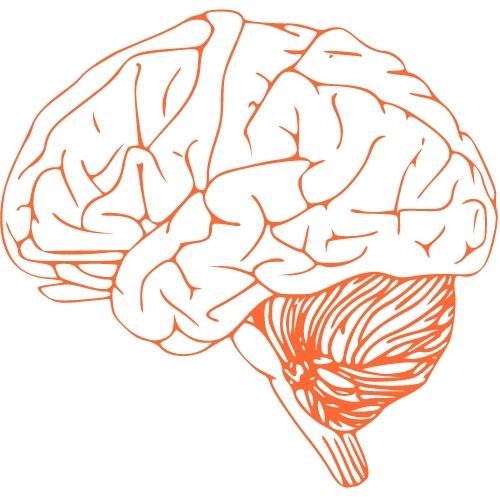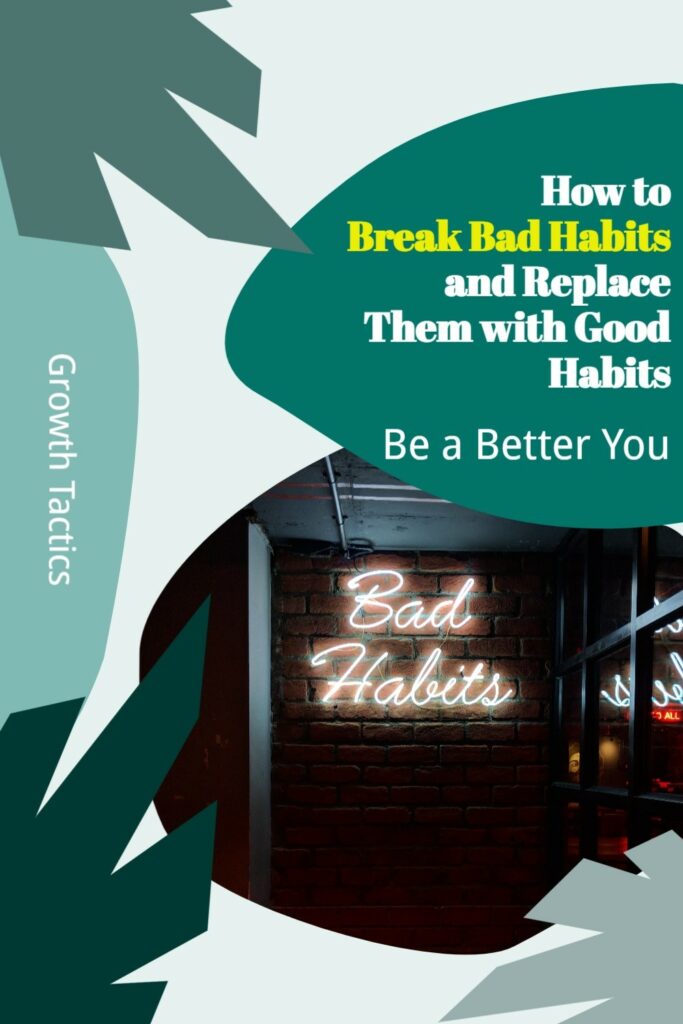Do you have any bad habits? If your answer is no, you’re lying to yourself. We all have bad habits. Some are worse than others, but you can break yours. In this article, I will provide tips and tricks to replace bad habits with good ones.
The more bad habits we can eliminate from our lives, the better our lives will be in the long run.
Jump To Section
Common Bad Habits List
Below are some of the more common examples of bad habits:
- Smoking
- Eating Sugary Foods
- Overeating
- Biting Your Nails
- Procrastinating
- Overspending
- Skipping Breakfast
- Negative Self-Talk
- Spitting
- Chewing With an Open Mouth
- Complaining
- Spending Too Much Time Scrolling Through Social Media
- Fiddling with Your Hair
- Being a Know-it-All
- Exaggerating
- Fidgeting
- Excessive Gambling
- Grinding Your Teeth
- Chewing a Pencil
Types of Bad Habits
Bad habits are synonymous with addictions. Some of these addictions are worse than others. Some cause possible illness or death. While others can cause discomfort or monetary losses.
All of these habits fall into two categories of addiction. The first is a chemical addiction. For example, smoking and eating sugary foods cause a chemical addiction in your body. Which makes you want more.
The other type of habit is a behavioral addiction. This occurs when you have an uncontrollable habit of doing something like negative self-talk or spitting.
Bad habits are not all created equally, but we should do our best to strive to eliminate all the bad habits from our lives.
Who do Bad Habits Affect?

Bad habits always affect us in some way, but they often affect everyone around us too. When they get too out of hand, our loved ones are the ones that are affected the hardest. Sometimes they just cause irritation like being a know-it-all, or they could cause health problems to those around us like smoking.
The Science of Habits: Why Is It So Hard to Break Bad Habits?
Neurons in your brain fire at the beginning of new behavior. They settle while the behavior is occurring. Once the behavior is done, neurons begin firing again. Patterns begin to form in the brain making it extremely hard to change these bad habits.
The brain makes these actions almost automatic, to enable us to use our brains for other things. This is great for activities like walking or driving. But when it comes to something negative it can make it even more difficult when you want to change.
Pleasure-based habits are even harder to break. When you do an enjoyable activity, your body releases a chemical called dopamine. Dopamine makes you crave something when you are not doing it. In other words, habits form from the release of this dopamine.
For these reasons, roughly 70% of smokers say they would like to quit, but they still smoke. The good news is that with all these things working against us in our brains, we are all still capable of change. We are not robots. Even if we have trained our brains to act in a certain way or crave a certain thing, we can rewire it. It’s never easy to break a bad habit, but it is worth it in the end.
How Long Does It Take to Break Bad Habits?

There is no real set amount of time it takes a person to break a bad habit. It can be anywhere from days to years. Many factors go into how long it will take you to break a habit:
- How long this habit has been a part of your life?
- How integrated this action is in your life?
- What social, physical, or emotional rewards come from this habit?
- The support of people around you.
- Your motivation for quitting or getting rid of the bad habit.
Although there is no set timeline, the British Journal of General Practice conducted a study. Their study suggests that 10 weeks is a realistic time frame for most people. By the 10-week time frame, a new habit should be almost automatic.
What is the 21/90 rule?
There is a popular belief out there called the 21/90 rule. This rule states that “It takes 21 days to build a new habit and 90 days for it to become a lifestyle change.” This is great for starting out but can be a little deceiving.
It may take more or less than 21 or 90 days to form new habits and lifestyle changes. Even after that time has passed, you have to keep committing. You can’t give up because you’ve made it to the specified number of days.
That being said, the 21/90 rule can be a great starting point. For instance, you may have a habit of throwing your dirty laundry on the floor. So you may say “For the next 21 days I will put my laundry in the basket.” After those 21 days it may or may not have become automatic, so you may have to reevaluate.
What Are the Steps for Breaking Bad Habits?
Recognize Your Bad Habit
Of course, your first step to breaking bad habits is to recognize your bad habit. You can’t fix something until you acknowledge there is a problem.
Think about all the negatives this habit causes and make a list. Instead of writing down the negatives though, I want you to write down the positives of not doing the habit. For example, if I’m quitting smoking my list might look like this:
- Be healthier
- Live longer
- Smell better
- Save money
- Additional time
Think about how good your life is when you eliminate this bad habit from it. Picture yourself without this bad habit.
Set Your Goals
Are you struggling to break free from bad habits that hold you back? It’s time to set SMART goals to help you overcome those pesky obstacles. SMART goals, which stand for Specific, Measurable, Achievable, Relevant, and Time-bound, provide a clear and effective framework for creating a well-defined goal. By using this approach, you’ll have a higher chance of success, as it enables you to track your progress and stay focused on what truly matters to you.
Begin by identifying the bad habit you want to break and then craft a SMART goal to guide your journey. For example, if your goal is to quit smoking, make it specific by aiming to reduce the number of cigarettes you smoke daily. Measure your progress by keeping a log of your daily intake, and ensure it’s achievable by setting incremental targets. Keep your goal relevant to your overall well-being, and set a time-bound deadline to motivate you to stay on track. With SMART goals in place, you’ll be well-equipped to tackle those bad habits and pave the way for a healthier, more fulfilling life.
Identify Triggers

Triggers are things that make or remind you to do your bad habit. An easy trigger to recognize is seeing someone else doing the same bad habit but with most habits, there are more triggers than that.
Making a list of your common triggers at this point is a good idea. We will use this list a little later.
Some common triggers for bad habits are:
- Boredom
- Stress
- Anger
- Sadness
Replace the Bad Habit With a Healthier Habit
Now take the list of triggers and replace these triggers with good action. For instance, if you want to smoke when you get bored, try doing 5 push-ups instead. This is how you change unhealthy habits into good ones.
Even if you can’t find something good to replace your bad habit with, replace it with something better. If the first thing you do when you get in your car is light up a cigarette, instead try chewing some gum. This is one of the more effective and sustainable ways to break bad habits.
What to Do When Setbacks Happen
Experiencing setbacks is a natural part of the process when attempting to break free from bad habits. It’s crucial to accept that these setbacks will occur and not dwell on them or let them derail your progress. The key is to persevere and continue striving for improvement, rather than becoming discouraged by occasional slip-ups.
Instead of punishing yourself for setbacks, use them as opportunities for growth and learning. Recognize that overcoming bad habits is an ongoing journey, and setbacks can serve as valuable lessons that help you better understand your triggers and weaknesses. By reframing these experiences as teachable moments, you can shift your focus from dwelling on past mistakes to developing strategies for future success.
To maintain a positive mindset, concentrate on the progress you’ve made and the steps you can take to avoid repeating the same mistakes. Reflect on the circumstances that led to the setback, and consider how you might alter your approach or environment to minimize the chances of it happening again. This proactive mindset will help you stay focused on your goals and strengthen your resolve to break the bad habit.
List of Good Habits to Replace Bad Ones
| Bad Habit | Good Habit |
|---|---|
| Skipping Breakfast | Eating a Healthy Breakfast |
| Procrastinating | Setting Small, Achievable Goals |
| Negative Self-talk | Practicing Positive Affirmations |
| Inconsistent Exercise | Following a Workout Routine |
| Excessive Screen Time | Reading a Book or Journaling |
| Late-night Snacking | Drinking Water or Herbal Tea |
| Impulse Buying | Creating and Sticking to a Budget |
| Poor Sleep Schedule | Establishing a Bedtime Routine |
| Junk Food Eating | Choosing Fruits and Vegetables |
| Complaining Often | Practicing Gratitude |
| Not Drinking Enough Water | Keeping a Water Bottle Nearby |
| Smoking | Deep Breathing Exercises |
| Overworking | Scheduling Breaks and Leisure Time |
| Poor Posture | Practicing Good Ergonomics |
| Not Keeping in Touch | Setting Reminders to Call Friends/Family |
| Mindless Social Media Scrolling | Setting Time Limits |
| Ignoring Mental Health | Meditating or Practicing Mindfulness |
| Disorganized Space | Tidying Up a Little Each Day |
| Overeating | Eating Mindfully and Slow |
| Not Prioritizing Tasks | Creating a Daily To-Do List |
| Neglecting Personal Growth | Reading or Taking Online Courses |
| Wasting Time | Planning Your Day the Night Before |
Remember, each habit you change brings you closer to your goals. It’s not about being perfect. It’s about making progress and staying true to your purpose.
Find what fits your life. Start small and be kind to yourself. You have the power to lead your own growth. Let’s make it happen!
Additional Tips for Success
Tell Some Friends

Friends and family members are great at helping stay on track. They will remind you and make sure you are doing what you need to.
Also, when you tell friends about your intentions to quit something, you don’t want to disappoint them. It’s a lot easier to ration with yourself about why it’s okay to give in. Friends and family will keep you honest.
Friends and family will also be there if setbacks happen. They will be that shoulder to lean on and hopefully encourage getting back on the horse.
Positive Internal Language
How we talk to ourselves controls a lot of our life. I don’t know if you’re familiar with the law of attraction but the whole concept behind it is positive internal talk.
This positive mindset means two things. First, try to avoid telling yourself you can’t do it. Instead, tell yourself when you do it. Next, don’t be negative about setbacks and moments of weakness. Everyone has moments of weakness. It’s how we handle those moments that define us.
Start Small
A wise man once asked me “How do you eat a whole cow?” I said, “I don’t know”. He said “One bite at a time”.
This saying goes for many things in our lives and breaking a bad habit is no different. Habits are hard to break but even small changes make a big difference. They eventually lead to or add up to big changes.
If you have a messy house, you may want to commit to picking up at least one item a day. If you are feeling motivated you can pick up more but only commit to one item. One item is so easy you can’t fail. This will lead to a clean house in no time because these little victories are motivating and lead to big changes.
Use the Power of Visualization

Visualization, when executed effectively, can be an incredibly potent tool for achieving personal and professional goals. By creating a mental roadmap for our subconscious, we essentially lay out the path to success, paving the way for our thoughts and actions to align with our desired outcomes. This powerful technique takes just a few minutes, yet can have a transformative impact on our lives.
The beauty of visualization lies in its simplicity and accessibility. To harness its power, start by finding a quiet space where you can relax and focus. Close your eyes and envision yourself as the person who has already conquered the challenges and accomplished the goals you strive for. Immerse yourself in this reality, feeling the emotions and sensing the environment associated with your success. As you do this, your subconscious mind will absorb these images and begin working to align your behaviors and decisions with your envisioned future.
It’s essential to practice visualization regularly to reinforce your goals and desires. By making it a daily habit, you’ll keep your aspirations at the forefront of your mind, ultimately guiding your actions in the direction of achievement. Visualization can be applied to various aspects of life, from breaking bad habits to enhancing personal relationships or advancing your career. Embrace the power of visualization, and witness your goals and dreams materialize before your eyes.
Reward Yourself
I was at a dolphin show not too long ago, and you know how they train dolphins? They start with simple tasks and every time the dolphin performs what the trainer is asking they get a treat. If they don’t do it they don’t get punished, they just don’t get a treat. Eventually, the dolphins are doing flips on command.
This same concept of positive reinforcement works with us too. If you are making progress, give yourself a treat. Reward yourself for doing a good job. You’ve earned it.
Give Yourself Time
Embracing change is a vital part of personal growth and development, but it’s essential to remember that significant transformations often require time, patience, and persistence. Whether you’re working to break a bad habit, improve your relationships, or pursue a new career, it’s crucial to understand that lasting change is rarely an overnight phenomenon.
As humans, we can be easily frustrated by the slow pace of progress, particularly when we are eager to see immediate results. However, our journey towards change is often a marathon, not a sprint. It’s essential to give ourselves the necessary time and space to gradually evolve, adapt, and grow. By doing so, we can avoid the common pitfall of becoming disheartened and giving up when we don’t see instant improvements.
To help maintain your motivation during the process of change, focus on small, incremental steps and celebrate the milestones along the way. Acknowledge your progress, no matter how minor, and use it as fuel to continue moving forward. Cultivate patience and resilience, knowing that meaningful change will come with time, effort, and consistency.
Join a Group
Joining a support group can be an invaluable resource in overcoming personal challenges and connecting with others who share similar experiences. These groups bring people together who are facing the same struggles, providing a safe space to share stories, offer advice, and gain encouragement.
For example, if you’re grappling with alcoholism, organizations such as Alcoholics Anonymous provide structured programs and peer support to help you navigate your journey to sobriety. By connecting with others who have faced or are currently facing the same challenges, you can draw on their experiences, learn from their mistakes, and gain strength from their successes.
In today’s digital age, finding a support group that aligns with your needs is easier than ever. A simple Google search can yield numerous options, including online forums, chat groups, and social media communities dedicated to specific topics and struggles. These virtual groups offer the added benefit of anonymity, which can be particularly helpful for individuals who may feel uncomfortable or vulnerable discussing their issues in person.
Aside from specialized groups, like those for addiction or mental health, there are also general support groups for personal growth, self-improvement, and maintaining overall well-being. These groups can help you develop healthy habits, enhance your relationships, and achieve your goals.
Utilizing Habit-Tracking Apps to Break Bad Habits
In today’s digital age, countless tools and resources are available to help individuals break bad habits and lead healthier lifestyles. One such tool is habit-tracking apps, which are designed to assist users in monitoring their progress, staying accountable, and ultimately, replacing negative habits with positive ones. In this section, we will explore the benefits of habit-tracking apps and provide a few examples of popular options available for download.
Benefits of Habit-Tracking Apps
- Accountability: Habit-tracking apps serve as a constant reminder of the goals you have set for yourself. By regularly inputting data and checking in on your progress, you are holding yourself accountable to your commitment to break the bad habit.
- Motivation: Many habit-tracking apps incorporate rewards, streaks, and achievements to encourage users to stay consistent in their efforts. These gamification elements can be highly motivating, making the habit-breaking process more enjoyable and engaging.
- Visual Progress: Habit-tracking apps often display progress in the form of charts, graphs, or other visual representations. These visuals allow users to see their progress over time, which can be incredibly motivating and satisfying.
- Customization: Most habit-tracking apps offer customizable features, allowing users to tailor the app to their specific needs and preferences. This personalization ensures that the app remains relevant and helpful throughout the habit-breaking journey.
- Community Support: Some habit-tracking apps include social features, such as forums or sharing options, enabling users to connect with others who are working towards similar goals. This sense of community can provide valuable encouragement and support, making the habit-breaking process feel less isolating.
Popular Habit-Tracking Apps
- Habitica: Habitica gamifies habit-building by transforming it into an RPG (Role-Playing Game). Users can level up their characters, complete quests, and earn rewards for maintaining good habits and productive routines.
- Streaks: Streaks is a straightforward habit-tracking app that focuses on maintaining streaks of consecutive days of successful habit completion. With a visually appealing design and a focus on simplicity, Streaks makes it easy to track habits and stay motivated.
- Done: Done utilizes visually appealing graphs and statistics to help users monitor their progress, set goals, and build positive habits. The app allows for tracking multiple habits and offers customizable reminders and notifications.
- Fabulous: Fabulous is a habit-tracking app that focuses on building healthy routines and habits through science-backed techniques. It incorporates personalized coaching and daily challenges to help users stay on track.
- Loop: Loop is an open-source habit-tracking app that emphasizes simplicity and ease of use. It offers customizable habit tracking, reminders, and visually appealing graphs to monitor progress.
When to Seek a Mental Health Professional
Breaking bad habits can be tough. Sometimes, we all need a little extra help. Knowing when to seek a mental health professional can make a big difference.
Struggling to Make Progress
You’ve tried your best, but you’re not seeing any changes. If you feel stuck, a mental health professional can help. They use tools like Cognitive Behavioral Therapy (CBT). This helps you understand and change your habits.
Feeling Overwhelmed
If breaking a bad habit makes you feel anxious or depressed, it’s time to ask for help. A professional can work with you. They will help you find ways to cope and feel better.
Impact on Daily Life
Some habits hurt your daily life. They might affect your job, school, or relationships. If your habits are causing problems, a mental health professional can guide you. They can help you make a plan to change.
Lack of Support
You don’t have to do it alone. Sometimes, friends and family can’t give you the support you need. A mental health professional offers a safe space. They listen and work with you to reach your goals.
Remember, asking for help shows strength. You’re taking a step towards a better you. Mental health professionals are there to support your journey. Trust in the process and believe in your ability to grow. You’ve got this!
Final Thoughts
It may seem daunting when you set out on a journey to break bad habits. You probably won’t break all your bad habits at once. Just take one bite at a time, and before you know it you will have made a ton of progress.
With the right mindset, you will achieve great things.
Did you find this article on how to break bad habits useful? Please don’t forget to share, so others can enjoy it.


